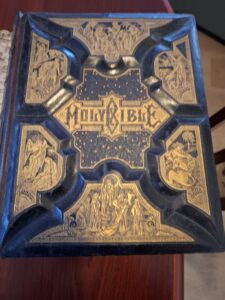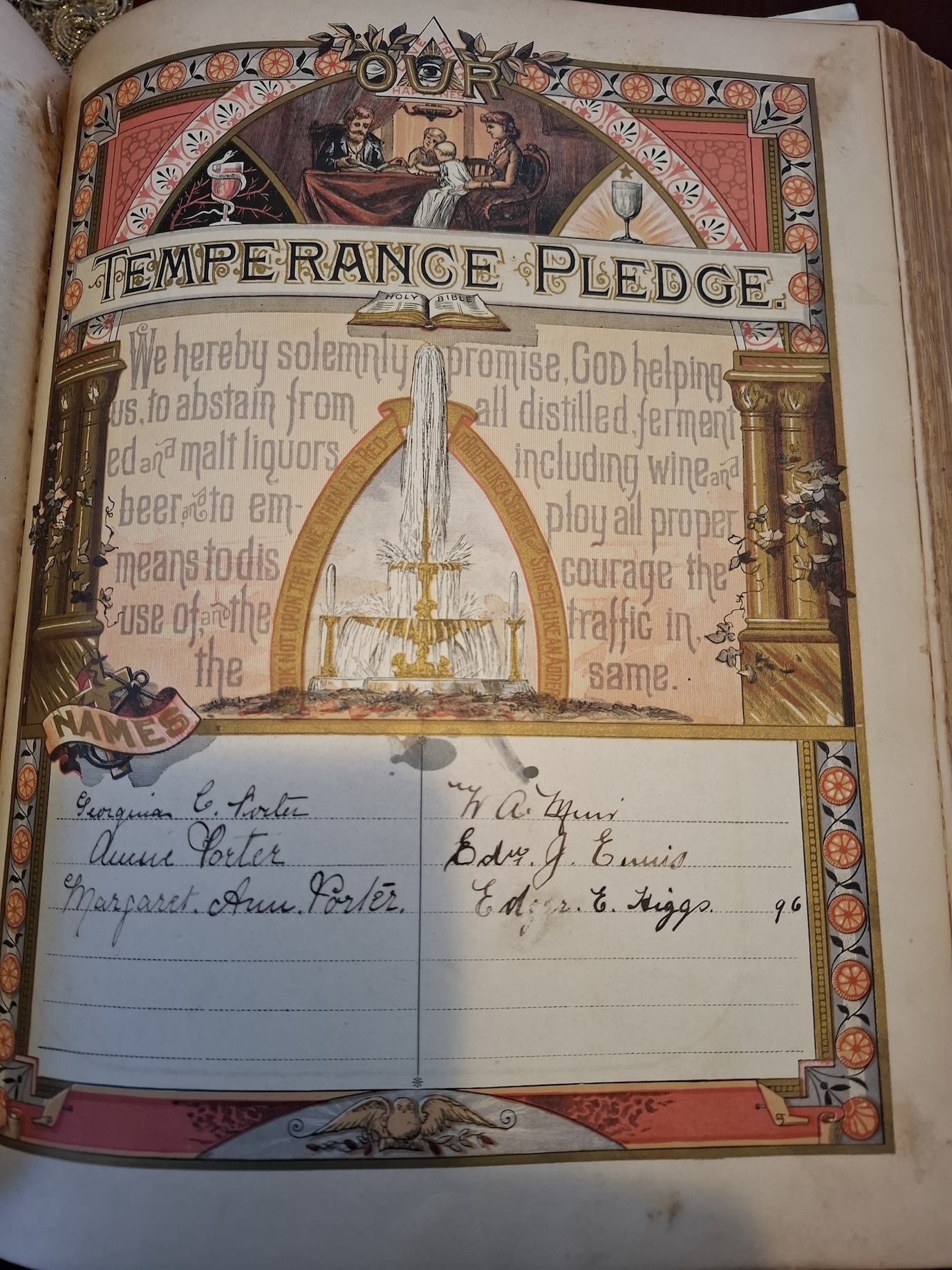The Temperance Pledge of days gone and my Porter family

Robert and Ann Porter’s family bible. Authors own image.
I am a very lucky family historian who inherited my paternal great-grandparent’s (Porter) family Bible. It lay in the bottom of my father’s wardrobe for many years, but then Dad passed it on to me. On the downside, very little was written in the Bible until my mother and I entered a small number of birth dates. The upside was that about six people had signed the Temperance Pledge page in the Bible. This page was located in the middle of the Bible, and I only recently discovered it.
My paternal great-grandparents were Robert Porter and Annie Scott Davidson, who emigrated as children with their parents and siblings to Queensland before it became a separate colony from New South Wales. The couple married in 1865 in Toowoomba but eventually settled at North Branch near Pittsworth. Their family comprised six daughters and two sons. The four eldest children were daughters, and three of them signed the Temperance Pledge in the Bible. These were Margaret Anne, born 1873; Annie, born 1874; and Georgina Campbell Porter, born 1878.
There are no specific dates associated with the signatures. The other three signatories are all male. One of these is Edw J. Ennis. Edward, or Ted as he was known, married Annie in 1897. The eldest daughter of the family, Mary, was married in 1896, and she did not sign the Pledge. The first three signatories likely signed the Temperance Pledge after Mary married and left home but before Annie married. There is also the number “96” next to the last signature, which confirms this theory.
What is the Temperance Pledge, you might ask? The Pledge was associated with the Temperance Movement and was related to limiting the consumption of alcohol. People were encouraged to sign the Pledge as a family. This is what happened in this instance as three sisters and one of their future husbands signed the Pledge. The other two signatories were distant family.
In Australia, the Temperance movement began in the 1830s, but it was more closely associated with limited abstinence. In the later 19th century, the Temperance movement shifted to total abstinence (or totalism) rather than limiting drinking.[1] The movement was associated with the emergence of the Independent Order of the Rechabites and the Women’s Christian Temperance Union (WCTU), which the WCTU supported. The Australasian president of the WCTU, Jessie Ackerman, visited Australia in 1889, 1891, and again in 1894, which further supports the possible signing date of around 1896/1897. The Rechabites were active in Australia from around the 1870s. The Pittsworth (near North Branch) chapter, with its connection to totalism, was active early in the twentieth century, and several members of the Porter family were involved.

The Temperance Pledge in the family bible of Robert and Ann Porter. Authors own image.
The residents of Pittsworth founded a lodge of the Rechabites on 5 July 1890, with seven full members, a half member, and four honorary members. Men were probably the full members, with women being the honorary members and children being the junior or half members.[2] Organisations with men-only membership were common at this time.
On 22 September 1896, the Pittsworth Lodge celebrated its sixth anniversary. The Darling Downs Gazette reported the following week that the Pittsworth Reform Tent was healthy in both membership and with their finances.[3] While they are not listed, I believe the Porter family and their friends were probably in attendance.
While Temperance was all the rage in the 1890s and onwards, the Porters in earlier times were not wowsers. When widowed, my great-great-grandmother, Ann Laird Porter, became a publican around 1867. Her husband, James Porter, died in 1859 in Ipswich, and at the time, Ann had three children under the age of twelve. Another family historian researching the Porter family found that between 1867 and 1869, Ann ran the Prince Alfred Hotel as part of her home on Smiths Creek. She lived on the Warwick Road at this time between Drayton and Eton Vale on the Darling Downs.[4]
The Temperance Movement in Australia aimed to reduce alcohol consumption and also sought to decrease the number of barmaids, reduce the number of hotels, and shorten hotel opening hours. However, female hotelkeepers were deemed to have a legitimate place in the industry. Clare Wright, in her book, “Beyond the Ladies Lounge”, states that female publicans were often seen as motherly figures.[5]

Annie Laird, later Porter, later Bland. Authors own image
Ann was in her mid-fifties when she was a publican, so she likely presented herself to her customers in a maternal image. However, her time as a publican was brief. Ann remarried in 1870, only to be widowed again in 1882. Ann did not return to hotelkeeping.
Two generations later, Ann’s granddaughter, Ruth Matheson (née Porter), also was a publican for a short time after her husband’s death. Ruth’s world was shattered when her husband, Archie, died in a motor vehicle accident, and she became a single parent with two young daughters. The widow needed to earn an income, and she became the licensee of the Westbrook Hotel in May 1914. Australian authorities were supportive of married, widowed or even single women as hotel licensees as they believed they maintained respectable premises.[6] Hotel keeping was a short interlude for Ruth as she only remained at the Westbrook Hotel until around mid-1915.[7] In July 1915, Ruth relocated to the Wide Bay region and took on the role of storekeeper.[8] The following year, Ruth remarried as her grandmother had.[9]
The Temperance movement aimed to improve Australian society during colonial times and following Federation. Life, however, presented numerous challenges to women during this period. Widowhood was often accompanied by single parenthood, which limited the options available to many women, including those in my family.
[1] ‘Temperance movement in Australia – Wikipedia, https::en.wikipedia.org/Temperance movement in Australia, accessed 24 May 2025.
[2] ‘Rechabitism at Pittsworth’, Toowoomba Chronicle and Darling Downs General Advertiser, 25 August 1891, p. 3. c. 7.
[3] ‘Pittsworth. Rechabites Anniversary’, Toowoomba Chronicle and Darling Downs General Advertiser, 29 September 1896, p. 3, c. 6.
[4] David Laidley, personal research.
[5] Clare Wright, Beyond the Ladies Lounge: Australia’s Female Publicans. The Text Publishing Company, Melbourne, 2003, pp. 152-157.
[6] Ibid, p. 52.
[7] ‘Local and general’. Licensing Court.’, Darling Downs Gazette, 13 April 1915, p. 4, c. 4,
[8] Queensland Electoral Commission, ‘Queensland State Electoral Roll, 1915’, Division of Wide Bay, Tiaro Division, p. 16, https://www.findmypast.com.au/, accessed 4 January 2020.
[9] Marriage Source Image for Joseph Leonard Franz Anderson and Ruth Mathieson, married 4 March 1916, Queensland, Queensland Registry of Births, Marriages and Deaths, 1916/C/620.

Great story Marg. I was brought up in the Methodist church and remember signing a temperance pledge at Sunday School ( although it didn’t last later on). I think back in the later 1800s, running a hotel or inn was a more common way for people to earn a living. One of my husband’s family had been a publican in England and later ran an inn from his home in Allora. He later became very involved in the church, donating land and becoming a church warden.
Yvonne, thanks for sharing. It is good to know other families had similar experiences.